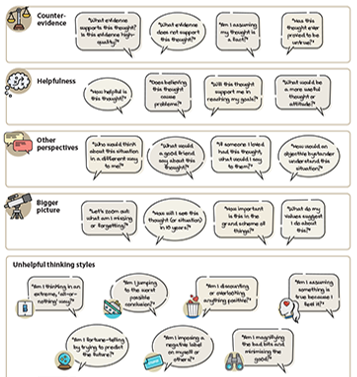Troubleshooting
Problem solving in this type of therapy consists of learning skills that give us the tools to identify and dispute irrational beliefs. Learning to replace ineffective ways of thinking with effective and rational cognitions.
The person will try to be very mindful of their thoughts and actions and expression of feelings. The person is encouraged to be less emotionally reactive and to change irrational beliefs and PANS (Automatic Negative Thoughts) to more functional thoughts.

Detention of thought
Thought stopping consists of stopping negative thoughts that are constantly present with a key word, e.g. STOP.
Stress inoculation
Stress inoculation is based on the fact that the stressful situation is known in advance, so there is anticipatory anxiety and this technique helps to control this anxiety.
This technique has 4 phases:
- Pre-phase: Develop a coping plan and eliminate and change negative thoughts.
- Contact phase: Reinterpret stress as positive, manage the stress response, implement the plan and reaffirm coping skills.
- High anxiety phase: Introduce an anxiety thermometer and ask yourself how much anxiety I have. Then, motivate myself with phrases such as: “other times it has been worse”, and then, reduce the stress; “I am going to control it a little”, “I am going to lower it by taking 3 deep breaths”, “calm down”, “wait a little longer, it will go down now, I am doing well”.
- Final phase: Objectively evaluate the confrontation, eliminate feelings of guilt or hopelessness and self-reinforce.

Covert awarness-raising
Covert sensitisation is a way of eliminating deep-rooted habits that give the person great pleasure, such as smoking, drinking alcohol, etc.
In this technique we associate the habit with unpleasant or aversive imaginary stimuli, such as nausea, pain, among others.
In our case we will use it to eliminate habits associated with stress.

Ellis’ Rational Emotive Therapy
Ellis’ REBT technique consists of the ABC of irrational beliefs, where:
- A is the activating event or objective situation: The first column records the objective event that ultimately leads to some form of heightened emotional response or negative thought.
- B is beliefs: The second column collects the perception, interpretation, belief, or thought you have about “A”. Beliefs can be rational or irrational. A belief is rational when it is empirical, logical and functional, and usually takes the form of preference (wishes or hopes), acceptance, tolerance and relativism, and includes yes/also, or yes/but meanings to the unpleasant “A” they are experiencing: “I hope such a misfortune will not happen to me, but if it does, I can cope with it and still have opportunities to be happy”. Whereas it is irrational when it is magical, illogical and dysfunctional, and usually takes the form of demand, condemnation, intolerance and drama, and includes o/o meanings: “I must prevent such a misfortune from happening or I will be miserable all my life”.
- C is the consequence: The third column reflects the physiological, somatic reaction and action tendencies that occur in response to “A”. There are healthy (or healthy) and unhealthy (or unhealthy) emotions that lead to constructive (or creative) and destructive (or defeatist) behaviour, respectively.
Ellis explains that he believes that the trigger is not the event (A), and that it does not cause the negative emotional and behavioural consequences (C), but that the person interprets these events in an unrealistic way, and therefore has an irrational belief system (B) that helps to cause the consequences (C).

References
[1]
La inoculación del estrés: C. Ibáñez-Tarína, R. Manzanera-Escart (2012)
[2]
La sensibilización encubierta: Joseph R. Cautela (1966)


